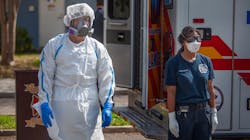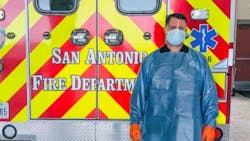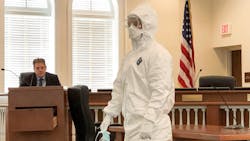COVID-19: Resources to Keep you Safe and Informed
Editor's note: Find Firehouse.com's complete coverage of the COVID-19 pandemic here.
The following is a breakdown of the spread of the coronavirus and how it has been affecting firefighters and other first responders, according to the International Association of Fire Chiefs. (UPDATED: 4:37 p.m., Friday, April 24)
Confirmed Cases
- Global: 2,789,315
- United States: 889,661
Deaths
- Global: 195,775
- United States: 50,890
U.S. First Responders Affected
- Testing Positive for Coronavirus: 686
- Exposed to Coronavirus: 12,742
- Quarantined: 12,456
Coronavirus Resources
- FDOSA Offers Guidelines to Reduce Station COVID-19 Exposure
- International Association of Fire Fighters Tool Kit
- International Association of Fire Chiefs Resource Page
- EPA List of Disinfectants to Use Against COVID-19
- FDSOA COVID-19 Safety Recommendations
- COVID-19 Stimulus: How It Helps Fire, EMS Departments
Watch IAFF's Briefing on Coronavirus Outbreak
Watch IAFC's COVID-19 Webinar
As the World Health Organization declared the international outbreak of the coronavirus to be a global epidemic this week, the health crisis ground everyday activities to a halt in the United States.
President Donald Trump announced a 30-day European travel ban during a national address Wednesday night. Numerous universities across the country, from Harvard to Stanford, moved their classes online, while New York, Illinois, Ohio, Oregon, California and other states and cities instituted gathering restrictions.
Large and iconic city events, such as the Chicago and New York City St. Patrick's Day parades and the Boston Marathon, have either been canceled or postponed, and the self-proclaimed happiest places in the world—Walt Disney World in Orlando, FL, and Disneyland in Anaheim, CA—have been closed.
The sports world, however, was the most profoundly effected by the virus Wednesday. The NBA suspended its season after at least one player tested positive for COVID-19, and the NCAA cancelled its annual March Madness basketball tournament, as well as all of its remaining sports championships. Major League Baseball also shut down Spring Training and announced it would be delaying the start of the regular season by at least two weeks.
From the outset, fire departments and EMS agencies around the country have been on the front lines of the outbreak, bringing with it a unique set of risks as first responders come in contact with infected patients. In Kirkland, WA—a suburb of Seattle—more than 25 firefighters have been quarantined after dealing with cases of the virus at a local care center. This week, an FDNY EMT and firefighters in Alameda, CA and San Jose, CA both tested positive for the virus.
RELATED:
- IAFC Builds Coronavirus Resource; Global Emergency Called
- TX Coronavirus Patient Transported in Special Ambulance
- WA Fire Station Quarantined after Possible Coronavirus Exposure
- CA Firefighters in Isolation after Possible Coronavirus Contact
- FFs' Isolation Ends after CA Patient's Coronavirus Test Negative
- FFs in WA Coronavirus Cases Showing 'Flu-like' Symptoms
- Firefighters Quarantined as CA Declares Coronavirus Emergency
- FDNY Prioritizing Resources on Coronavirus Calls
- Coronavirus Testing at Sub-Station Upsets Boston's EMS Union
- FDNY EMT Tests Positive for Coronavirus
- FFs who Helped GA Teacher with Coronavirus Quarantined
- Firefighters Back to Work after CA Man Tests Negative for Coronavirus
- CA Firefighter Tests Positive for Coronavirus
- Miami Firefighter Hospitalized, Tested for Coronavirus
- COVID-19 Infects Four CA Firefighters; Nearly 80 Quarantined
- Quarantined FFs Attended FL Event with COVID-19 Patient
- Firefighters Cleared after Treating CA's First Coronavirus Fatality
- Eight CA Firefighters Placed in Isolation
- KS Firefighters Self-Isolate after Treating Coronavirus Patient
- Quarantine of Brooklyn FFs Pushes FDNY Count to Nearly 100
- Coronavirus-Infected Firefighter Total for CA City Jumps to 10
- FL Lawmaker: FFs Should 'Take One for Team' with Pandemic
- 'Tertiary Contact' with SC Coronavirus Patient Quarantines FF
- Southern CA Firefighter Tests Positive for Coronavirus
- Ex-FDNY Fire Marshal Dies from Coronavirus Complications
- OH Cities Could Share FFs if COVID-19 Spreads in Departments
- TN Firefighters Quarantined, Crew in Isolation for COVID-19
- NY Responders Ask Callers for COVID-19 Warnings
- Chicago FD Paramedic Tests Positive for COVID-19
- Coronavirus Threatens to Thin FF Ranks in Los Angeles Area
- NY Responders Ask Callers for COVID-19 Warnings
- Chicago FD Paramedic Tests Positive for COVID-19
- Coronavirus Threatens to Thin FF Ranks in Los Angeles Area
- CT Chiefs: FFs, Police Lack Protective Gear for Coronavirus
- Pittsburgh FFs Won't be Notified of Coronavirus Exposure
- Dozens of AL Firefighters, Medics Receive Coronavirus Training
- KY Child Care Center Closures Create Dire Dilemma for FFs
- OH Firefighters Not Told of Possible Coronavirus Exposure
- CA County First Responders Prioritized for Coronavirus Tests
- Coronavirus Infects Three DC Firefighters; 141 Quarantined
- OH Fire Department Splits Staff to Combat Coronavirus
- FDs in Chicago Suburbs Cautious amid Pandemic
- Orlando FFs in Quarantine after Coronavirus Exposure
- AZ Station Set to Close will Remain Open During Pandemic
- PA Responders Concerned About Training, Supplies
- CA Firefighter Tests Positive for Coronavirus; 24 Others to Self-Isolate
- OH County Asking for Spare PPE for Firefighters
The San Antonio Fire Department was one of the first departments to confront coronavirus head on. Although the city didn't have its first confirmed case until March 13, the department's EMS Infectious Disease Response Unit called in to transport crusie ship passengers potentially infected with the virus to the Joint Base San Antonio Lackland military facility earlier this month.
Before this pandemic, the team consisted of 30 paramedics who went through nearly 20 hours of training in PPE and the handling of infectious patients, said San Antonio Fire Chief Charles Hood. The unit was established in 2018 in response to a Texas Ebola outbreak, and members had been deployed in the past to transport patients infected with that virus.
"This team has functioned well in response to this event, and IDRU personnel have transported many patients from the Lackland AFB quarantine area for quarantine in another location.," Hood said.
When it comes to treating San Antonio residents who might be carrying the virus, Hood said the department has emphasized the importance of distance assessments and using airborne and universal precautions. Dispatch procedures also have been amended to include "targeted questions to give any possible warning to our responders, as well as established special instructions for dispatchers when sending units to high occupancy locations, especially those with persons with higher risk of illness."
"Incidents with patients that have a legitimate concern of possible infection, now requires our personnel to contact our regional advisory council network that will place key persons (EMS leadership, Medical Direction, Regional Trauma Advisory Council leadership, and San Antonio Metropolitan Health District immunologists) on a conference call to evaluate the risk level, patient care, transport decisions and destinations for transport," Hood added.
Besides treating patients, Hood said he also concerns for firefighters and paramedics during this pandemic. However, the department is preparing for an eventuality that could involve multiple members becoming infected or being quarantined after being exposed to the coronavirus.
"Another concern is what happens if I have to shut stations down due to illness or self-quarantine?" he said. "We have examined and updated our Continuity of Operations plans to safely staff and deliver service with a loss of 10, 30 and 50 percent of our staff."
"I have been in this business for a long time," Hood added. "I have witnessed, HIV, H1N1, SARS and Ebola, never in my career have I seen a virus spread so rapidly. I have been blessed to deploy to some of the largest incidents in this nation’s history, never have I seen the amount of planning that has taken place over the past six weeks in preparation for what will be an unknown response with no true data. It’s very concerning."
And Hood's shock at the rapid global spread of COVID-19.
"Throughout my career, I have seen emerging diseases and flu outbreak," Champaign, IL, Fire Chief Gary Ludwig, who has spent more than 40 years in the fire service, told Firehouse.com. "This has taken higher precedence. I find it ironic that the CDC's website lists an estimated 20,000 to 52,000 deaths from flu in the United States between October 1, 2019 and February 29, 2020. At its highest, that is approximately 350 deaths a day. There is no news coverage of these deaths. No matter what the strain of flu, we should always take precautions to protect our firefighters, EMS personnel, and first responders."
Given the virulent nature of the virus and the current lack of large-scale testing and a vaccine, departments have adapted their policies and protocols to reflect this new—and hopefully temporary— normal. For Ludwig's Champaign department, the emphasis has been on taking proper personal protective equipment precautions on calls when responders aren't sure if a patient has the virus.
Other modifications include:
"If you go on a suspected call, use appropriate exposure guidelines," Ludwig wrote in an email update to his department. "It is recommended that one person go to the door if possible while the others stay back. If possible, have the patient come outside and try to stay 6 feet away from the patient during triage. If coughing is an issue, place a mask or NR on the patient ASAP to prevent droplet contamination. We will treat all patients as always but please use good PPE practices, good hygiene after a call, and minimize contact if at all possible.
"If a medic unit goes on scene first, stay back unless you are needed. The goal is to decrease exposure risk. The goal will also be to try and stretch our PPE supply. If only one person is using PPE on a call, while the others are back 6 to 10 feet, that’s OK. Most importantly, protect yourselves and treat the patient as needed."
Ludwig also stressed proper decontamination of all gear and equipment "as you would any other call with an exposure." The department purchased two new electromagnetic sprayers to help with that.
Serving the community at the University of Illinois brings additional considerations for Ludwig's department and his personnel.
"We have been on notice since late December since we have over 5,000 students taking classes at our university," Ludwig said. "The University of Illinois has been diligent with monitoring students who might have traveled overseas or returned after the Christmas holidays from Asia. It has only been as of late that we went to higher phases as cases ramped up in the United States."
Of course, Champaign isn't alone when it comes to adopting new tactics in dealing with this pandemic. The International Association of Fire Fighters and the International Association of Fire Chiefs have both created "tool kits" for first responders on how to handle coronavirus calls. Their recommendations, which can be found online, are being updated as more is learned about the virus, with the IAFF even holding a national health briefing for its members early this week.
Here's a look at what other cities across the country are doing to stem the spread of coronavirus.
FDNY
New York City firefighters are no longer being sent on medical emergencies involving patients with symptoms connected to the virus. Paramedics and EMS members will still answer calls concerning asthma attacks, coughs and breathing issues, but they won't be accompanied by structural firefighters.
The decision has been largely criticized by the city's EMS union officials, who have recently been seeking pay equity within the department.
"It is not the first time EMS has acted as the canary in the coal mine to protect the public, and it won’t be the last. It’s important now more than ever for the Mayor to acknowledge the work we do," Oren Barzilay, president of the union representing New York City EMS personnel, told the New York Daily News.
But the department has defended the move as a way to prioritize city resources.
“Firefighters continue to respond to the highest priority medical calls, whether they are potential COVID-19 calls or not, including all segment 1 incidents, cardiac and respiratory arrests, choking, and trauma incidents,” an FDNY spokesman told the Daily News.
“On every call type, additional fire and EMS resources can be dispatched as needed,” he added.
Cleveland
Cleveland and Cuyahoga County have activated their emergency operations center and joint information center to help coordinate the coronavirus response throughout the area. The center is brought online for big emergencies, and it includes city, county and state emergency management offices, as well as fire and police representatives.
The center helps spread information about the virus to both first responders and the public, and it monitors emergency supplies throughout the area, making sure communities have enough masks, disinfectants and other items. Ultimately, it's tasked with “making sure everybody’s on the same page so we can make sure proper guidance and information is flowing correctly,” Cuyahoga County Public Safety Director Alex Pellom told the Cleveland Plain Dealer.
Los Angeles County
Since the coronavirus outbreak has reached crisis levels, the Los Angeles County Department of Public Health has been holding conference calls three times a week with emergency officials in the county to provide updates.
Like the Champaign Fire Department, Los Angeles County firefighters are putting a new emphasis on PPE when responding to calls with potentially infected patients.
"For the majority of the incidents that we respond to, we wear latex gloves that protect us and the patient," Sean Ferguson, an inspector with the department, told KABC-TV. "However, based on a line of questioning that the dispatcher receives or through our assessment of the patient on scene, we may ramp up the level of personal protective equipment that we do wear."
Departments in the county, such as the San Marino Fire Department, are making sure they're stocked up on special disaster kits, which include gowns, safety glasses, disinfecting towelettes, biohazard bags and respirator masks, the San Marino Times reports. Dispatchers also are screening calls so that firefighters will better know if they're responding to a call potentially involving a coronavirus patient and will need those kits.
Sacramento, CA
Seattle Area
With more than 440 confirmed cases, Washington State and the Seattle area in particular have been hard hit by the outbreak. Kirkland, a King County suburb of Seattle, has had more than two dozen Kirkland firefighters quarantined because of contact with infected patients at a care center.
Firefighters in Seattle and the surrounding communities are being extremely cautious about who enters the scene of an emergency call that could include a person carrying COVID-19.
"Our plan is right now to limit the amount of people that go into the incident," East Pierce firefighter Jeff Collins told NPR. "And if we have a high index of suspicion, everyone inside will be wearing these gowns."
Orlando
Along with expanded PPE and dispatch screening provisions, the Orlando Fire Department is being diligent to disinfect its ambulances to prevent the spread of the virus, the Orlando Sentinel reports. Last week, the department ordered a fourth disinfecting machine, which fills a vehicle's cabin with a thin peroxide mist to eradicate harmful elements.
So far, no department members are being monitored for exposure to the coronavirus, but there are plans in place to restrict duties of employees in those cases, Chief Benjamin Barksdale told the Sentinel.
Miami
Cobb County, GA
Cobb County, GA, firefighters now respond to medical calls wearing protective masks, glasses and gloves. The change in procedure comes after seven Cobb firefighters were exposed to a patient who tested positive for COVID-19, the Atlanta Journal-Constitution reports.
The firefighters were quarantined, and none of them became infected with the virus.
Fort Worth, TX
Newport, RI
With the supply of N95 masks limited across the country, Newport, RI, firefighters and police officers are trying to extend the lifespan of the masks they do have. The normally one-time use masks are now being disinfected so they can be reusable, the Newport Daily News reports.
The police department is expected receive more masks by mid- or late April, the Daily News added.
A mask shortage also has led to fraudulent N95s to hit the market. Mask manufacturer 3M has issued a warning about counterfiet items and given a checklist of how to tell the difference between a fake and the real thing:
- Respirators will be sold in 3M packaging, with model-specific user instructions accompanying the product
- They should not be sold individually, loose in large bags or boxes or without packaging and Instructions
- Masks with missing missing straps, strange odors, blocked valves, misspelled words and other flaws are likely not 3M respirators because of the company's strickt quality controls.
Any fraudulent masks should be reported to 3M via the company's website.
Sterling Heights, MI
Simarlarly, the Sterling Heights, MI, Fire Department has a backup plan if it runs out of N95 masks. Fire Chief Chris Martin told the Detroit Free Press that first responders could use the same masks they wear to fight fires.
"We will certainly protect our employees and at the same time render the care we need to render," he told the news outlet.
For first responders, caution has been the buzzword when weathering the coronavirus outbreak. Fortunately, it might be simple, everyday routines that keep those responding to COVID-19 emergencies safe, as well as stemming the spread of the virus.
"My advice to any first responder is to use common sense," Ludwig said. "Use proper PPE. Wash your hands often. Don't touch your face, nose and mouth without washing your hands. It is not always shaking hands with someone. It is touching of door handles, fruit at the store that someone picked up just prior to you, and other opportunities where the transmission can occur. Washing of hands with soap and water or other alcohol products should be used often."


